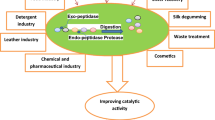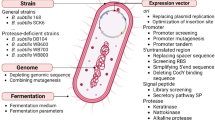Abstract
Metschnikowia reukaufii W6b isolated from marine environment was found to produce a cell-bound acid protease. The full-length cDNA (cDNASAP6 gene) of the acid protease (SAP6) from the marine-derived yeast M. reukaufii W6b was cloned. The insert was 1,755-bp long and contained an open reading frame of 1,527-bp encoding 508 amino acids. The deduced amino acid sequence included a signal peptide of 16 amino acids. The consensus motifs contained a VLLDTGSSDLRM active site and an ALLDSGTTITQF active site. The protein sequence deduced from the cDNASAP6 gene exhibited 12.9% overall identity with Cwp1 of Saccharomyces cerevisiae and a hydropathy profile characteristic of glycosylphosphatidylinositol cell-wall proteins. The cDNASAP6 gene without 48 bp encoding the signal peptide sequence was subcloned into an expression plasmid pET-24a (+) and fused with a 6-His Tag and transformed into Escherichia coli BL21 (DE3) for recombinant expression of the protease. The expressed fusion protein was found to have a unique band with molecular mass of about 54 kDa. The crude acid protease of the culture of the marine yeast strain W6b and the crude recombinant acid protease had milk clotting activity.







Similar content being viewed by others
References
Kocabiyik, S., & Ozel, H. (2007). Bioresource Technology, 98, 112–117. doi:10.1016/j.biortech.2005.11.016.
De Viragh, P. A., Sanglard, D., Togni, G., & Falcetto, R. (1993). Journal of General Microbiology, 139, 335–342.
Kamada, M., Oda, K., & Murao, S. (1972). Agricultural and Biological Chemistry, 36, 1095–1101.
Maddox, I. S., & Hough, J. S. (1970). The Biochemical Journal, 117, 843–852.
Abdehl, A. T. H., Kennedy, E. H., & Ahearn, D. G. (1977). Journal of Bacteriology, 130, 1125–1129.
Tobe, S., Takami, T., Ikeda, S., & Mitsuzi, K. (1976). Agricultural and Biological Chemistry, 40, 1087–1092.
Nelson, G., & Young, T. W. (1987). Journal of General Microbiology, 133, 1461–1469.
Ray, M. K., Uma devi, K., Umar, G. S., & Shivaji, S. (1992). Applied and Environmental Microbiology, 58, 1918–1923.
Kitano, H., Kataoka, K., Furukawa, K., & Hara, S. (2002). Journal of Bioscience and Bioengineering, 93, 563–567.
Hube, B., Monod, M., Schofield, D. A., Brown, A. J. P., & Gow, N. A. R. (1994). Molecular Microbiology, 14, 87–99. doi:10.1111/j.1365-2958.1994.tb01269.x.
Chi, Z. M., Liu, Z. Q., Gong, F., & Li, H. F. (2006). Journal of Ocean University of China, 3, 243–247.
Ferri, S., Miura, S., Sakaguchi, A., Ishimura, F., Tsugawa, W., & Sode, K. (2004). Marine Biotechnology (New York, N.Y.), 6, 625–632. doi:10.1007/s10126-004-0001-8.
Gao, L. M., Chi, Z. M., Sheng, J., & Ni, X. M. (2007). Applied Microbiology and Biotechnology, 77, 825–832. doi:10.1007/s00253-007-1210-7.
Ni, X. M., Chi, Z. M., Ma, C. L., & Madzak, C. (2008). Marine Biotechnology (New York, N.Y.), 10, 319–327. doi:10.1007/s10126-007-9067-4.
Rhishipal, R., & Philip, R. (1998). Bioresource Technology, 65, 255–266. doi:10.1016/S0960-8524(97)00179-X.
Thompson, J. D., Gibson, T. J., Plewniak, F., Jeanmougin, F., & Higgins, D. G. (1997). Nucleic Acids Research, 24, 4876–4882. doi:10.1093/nar/25.24.4876.
Chi, Z. M., Ma, C. L., Wang, P., & Li, H. F. (2007). Bioresource Technology, 98, 534–538. doi:10.1016/j.biortech.2006.02.006.
Sambrook, J., Fritsch, E. F., & Maniatis, T. (1989). Molecular cloning: A laboratory manual (2nd ed., pp. 367–370). Beijing: Cold Spring Harbor Laboratory, (Chinese translating ed.).
Chi, Z. M., He, S., & Yao, S. M. (2005). Enzyme and Microbial Technology, 37, 395–401. doi:10.1016/j.enzmictec.2005.01.040.
Laemmli, U. K. (1970). Nature, 227, 680–685. doi:10.1038/227680a0.
George, V., & Diwan, A. M. (1983). Analytical Biochemistry, 132, 481–483. doi:10.1016/0003-2697(83)90037-4.
Larson, M. K., & Whltaker, J. R. (1970). Journal of Dairy Science, 3, 253–261.
Berridge, N. J. (1952). Analyst (London), 77, 57–62. doi:10.1039/an952770057b.
Wang, L., Chi, Z. M., Wang, X. H., Liu, Z. Q., & Li, J. (2007). Annals of Microbiology, 57, 495–501.
Kurtzmam, C. P., & Fell, J. W. (1998). The yeast: A taxonomic study (2nd ed., pp. 1–100). The Netherlands: Elsevier.
Kumar, S., Sharma, N. S., Saharan, M. R., & Singh, R. (2005). Process Biochemistry, 40, 1701–1705. doi:10.1016/j.procbio.2004.06.047.
Gonzalez-Lopez, C. I., Szabo, R., Blanchin-Roland, S., & Gaillardin, C. (2002). Genetics, 160, 417–427.
Clark, S. J., Templeton, M. D., & Patrick, A. (1997). Microbiology, 143, 1395–1403.
Yamada, T., & Orydziak, T. D. M. (1983). Journal of Bacteriology, 154, 23–31.
Hirata, D., Fukui, S., & Yamashita, I. (1988). Agricultural and Biological Chemistry, 52, 2647–2649.
Gomi, K., Arikawa, K., Kamiya, N., Kitamoto, K., & Kumagai, C. (1993). Bioscience Biotechnology and Biochemistry, 57, 1095–1100.
Ueda, M., & Tanaka, A. (2000). Biotechnology Advances, 18, 121–140. doi:10.1016/S0734-9750(00)00031-8.
Yue, L. X., Chi, Z. M., Wang, L., Liu, J., Madzak, C., Li, J., & Wang, X. H. (2008). Journal of Microbiological Methods, 72, 116–123. doi:10.1016/j.mimet.2007.11.011.
Shimuta, K., Oda-Ueda, N., Washio, M., Oyama, H., Oda, K., & Tsura, D. (2000). Bioscience, Biotechnology, and Biochemistry, 64, 1542–1546. doi:10.1271/bbb.64.1542.
Yamashita, I., Hirata, D., Machida, M., & Fukui, S. (1986). Agricultural and Biological Chemistry, 50, 109–113.
Acknowledgement
This work was supported by National Infrastructure of Natural Resources for Science and Technology Program of China (No. 2005DKA21209).
Author information
Authors and Affiliations
Corresponding author
Rights and permissions
About this article
Cite this article
Li, J., Chi, Z., Liu, Z. et al. Cloning and Characterization of a Novel Aspartic Protease Gene from Marine-Derived Metschnikowia reukaufii and its Expression in E. coli . Appl Biochem Biotechnol 159, 119–132 (2009). https://doi.org/10.1007/s12010-008-8400-3
Received:
Accepted:
Published:
Issue Date:
DOI: https://doi.org/10.1007/s12010-008-8400-3




